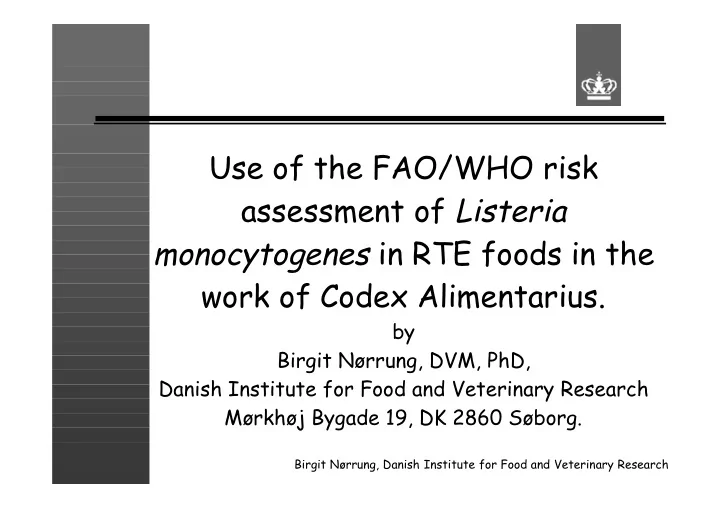

Use of the FAO/WHO risk assessment of Listeria monocytogenes in RTE foods in the work of Codex Alimentarius. by Birgit Nørrung, DVM, PhD, Danish Institute for Food and Veterinary Research Mørkhøj Bygade 19, DK 2860 Søborg. Birgit Nørrung, Danish Institute for Food and Veterinary Research
Overview of Codex initiatives Listeria monocytogenes has been on the agenda in Codex Committe on Food Hygiene (CCFH) since 1990 From 1990 to 1999 in the format of a discussion paper. Birgit Nørrung, Danish Institute for Food and Veterinary Research
In 1999 it was agreed to prepare the proposed draft guidelines for the control of L. monocytogenes in foods And to ask FAO/WHO expert consultation to perform a complete risk assessment before considering control measures in CCFH Birgit Nørrung, Danish Institute for Food and Veterinary Research
2000: risk management questions 1. Estimate the risk from L.m in foods when the organisms ranges from absence in 25g to 1000 cfu/g, or does not exceed specified levels at the point of consumption Birgit Nørrung, Danish Institute for Food and Veterinary Research
Risk assessment conclusions Table 6: Predicted annual number of listeriosis cases when the level of L. m. was assumed not to exceed a specified maximum value and the levels in L. m. in the food are distributed as indicated in Table 5. ( Serving size of 31.6g.) Level Maximum Dose Percentage of servings Estimated number of (cfu/g) (cfu) when maximum level listeriosis cases per year .04 1 100 0.5 0.1 3 3.6 0.5 1 32 1.7 0.7 10 316 0.8 1.6 100 3160 0.4 5.7 1000 31,600 0.2 25.4 Birgit Nørrung, Danish Institute for Food and Veterinary Research
Risk assessment conclusions The effect of introducing 10,000 servings contaminated with L.m. at a level of 1000/g would be compensated by removing a single serving contamined at a level 10 7 cfu/g Birgit Nørrung, Danish Institute for Food and Veterinary Research
Risk assessment conclusions The public health impact of L.m. is almost exclusively a function of the foods that greatly exceed the current limit be it < 0.04/g or 100/g Birgit Nørrung, Danish Institute for Food and Veterinary Research
Dose Response Models Used for Risk Characterization - exponential Risk of Severe Listeriosis 1,00 0,90 0,80 0,70 0,60 More Susceptible 0,50 Less Susceptible 0,40 0,30 0,20 0,10 0,00 0 2 4 6 8 10 12 14 16 Log (dose) Birgit Nørrung, Danish Institute for Food and Veterinary Research
2000: risk management questions 2. Estimate the risk for consumers in different susceptible population groups Birgit Nørrung, Danish Institute for Food and Veterinary Research
Table 8: Dose-response curves for different susceptible populations calculated using relative susceptibility information from France. Relative susceptibilities for the different sub-populations are based on the incidences of listeriosis cases (outbreak and sporadic) in these groups in 1992 (Marchetti, 1996). a Condition Relative Calculated r-value Comparable outbreak r-value susceptibility 1.41 x 10 -10 Finland butter 3 x 10 -7 Transplant 2584 4.65 x 10 -11 AIDS 865 -12 Cancer-Bladder 112 5.99 x 10 -12 Diabetes, non-insulin 25 1.34 x 10 dependent -12 Diabetes, insulin 30 1.60 x 10 dependent -13 Alcoholism 18 9.60 x 10 4.01 x 10 -13 Over 65 years old 7.5 5.34 x 10 -14 Less than 65 1 (reference pop) Birgit Nørrung, Danish Institute for Food and Veterinary Research
2000: risk management questions 3. Estimate the risk from L.m in foods that do and do not support growth under specific storage and shelf life conditions Birgit Nørrung, Danish Institute for Food and Veterinary Research
The ability of ready-to-eat foods to support the growth of L.�monocytogenes appears to increase the risk of listeriosis: by 100- to 1000-fold on a per serving basis It is not possible to present a single value for the increased risk for all RTE foods because of the divergent properties of the foods Birgit Nørrung, Danish Institute for Food and Veterinary Research
CCFH meeting 2001 guidelines for control of L.m. in foods based on risk assessment principles were presented The guidelines suggested a microbiological Criteria at 100/g at the point of consumption (FSO) The US view: Wait until the FAO/WHO RA is completed Birgit Nørrung, Danish Institute for Food and Veterinary Research
CCFH meeting 2003 A revised document taking into account results of RA was introduced Discussion of the format and title of the document Some indicated that development of Criteria was premature because of a lack of definition of FSO Birgit Nørrung, Danish Institute for Food and Veterinary Research
Conclusion CCFH meeting 2003 Guidelines on how to control/manage L.m in food production should be re- vised. Document on specific criteria could be considered at a future meeting Take into account the result of FAO/ WHO RA, espec. in the development of additional questions Birgit Nørrung, Danish Institute for Food and Veterinary Research
Regulators dilemma The issue of accepting a very low risk or infact significantly lowering present risk through A specific limit enforced rigorously in stead of a ”zero limit” that is unachievable represents a very important (communication) dilemma for which no good solution has yet been found Birgit Nørrung, Danish Institute for Food and Veterinary Research
Overall conclusion CCFH is not yet prepared to use the results of the WHO/FAO risk assessment in formulating specific limits Will they ever be? Birgit Nørrung, Danish Institute for Food and Veterinary Research
SUGGESTIONS Serious discussions should be under- taken in CCFH in order to agree on how WHO/FAO risk assessments could/should be used in future risk management activities within CCFH Birgit Nørrung, Danish Institute for Food and Veterinary Research
Recommend
More recommend